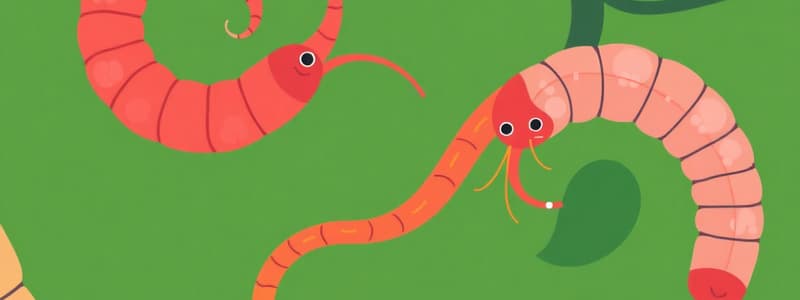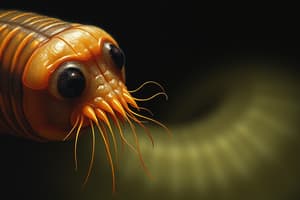Podcast
Questions and Answers
What characteristic distinguishes nematodes from other animal phyla?
What characteristic distinguishes nematodes from other animal phyla?
- They possess respiratory organs.
- They are exclusively marine.
- They have a noncellular cuticle. (correct)
- They have a segmented body.
Which of the following accurately describes the body structure of nematodes?
Which of the following accurately describes the body structure of nematodes?
- They have a tapered cylindrical body. (correct)
- They have a flat, segmented body.
- They have a rounded, unsegmented body.
- They have a flexible, polyhedral body.
What type of digestive system do nematodes possess?
What type of digestive system do nematodes possess?
- Incomplete digestive system with a single opening.
- Gastrovascular cavity functioning for digestion.
- Complete digestive system with a mouth and anus. (correct)
- Absorptive feeding system without a digestive tract.
How many sexes are present in nematodes, and which is usually larger?
How many sexes are present in nematodes, and which is usually larger?
What type of body cavity do nematodes have?
What type of body cavity do nematodes have?
What is the primary form of nematodes?
What is the primary form of nematodes?
Which feature is absent in nematodes?
Which feature is absent in nematodes?
What type of embryonic development do nematodes exhibit?
What type of embryonic development do nematodes exhibit?
What is the primary characteristic of animals classified under the phylum Annelida?
What is the primary characteristic of animals classified under the phylum Annelida?
Which environment do members of the phylum Annelida NOT inhabit?
Which environment do members of the phylum Annelida NOT inhabit?
How many species are estimated to exist within the phylum Annelida?
How many species are estimated to exist within the phylum Annelida?
What is the significance of the term 'Eumetazo' in relation to Annelida?
What is the significance of the term 'Eumetazo' in relation to Annelida?
Which of the following statements about annelids is true?
Which of the following statements about annelids is true?
Flashcards
Nematoda Phylum
Nematoda Phylum
A phylum of animals, also known as roundworms, characterized by a pseudocoelomate body and longitudinal muscles.
Pseudocoelomate
Pseudocoelomate
Animals with a body cavity not completely lined by mesoderm; fluid filled space.
Roundworms
Roundworms
Animals in the Phylum Nematoda, often parasitic, with smooth, unsegmented bodies.
Longitudinal Muscles
Longitudinal Muscles
Signup and view all the flashcards
Cuticle
Cuticle
Signup and view all the flashcards
Parasitic Nematodes
Parasitic Nematodes
Signup and view all the flashcards
Complete Digestive System
Complete Digestive System
Signup and view all the flashcards
Separate Sexes
Separate Sexes
Signup and view all the flashcards
Annelida Phylum
Annelida Phylum
Signup and view all the flashcards
Segmented Worms
Segmented Worms
Signup and view all the flashcards
Where do Annelids live?
Where do Annelids live?
Signup and view all the flashcards
Annelid Body Plan
Annelid Body Plan
Signup and view all the flashcards
Annelid Examples
Annelid Examples
Signup and view all the flashcards
Study Notes
Phylum Nematoda (Roundworms)
- Nematodes are a vast phylum, with around 12,000 known species and potentially 500,000 more.
- They are triploblastic and pseudocoelomates.
- They can be parasitic or free-living.
- Nematodes have elongated, cylindrical, smooth, and unsegmented bodies, usually tapered to a pointed posterior end and rounded anterior end.
- They have a noncellular cuticle, a resistant outer covering.
- Their digestive system is complete, with a mouth, esophagus, midgut, and anus.
- Nematodes are separate sexes, with females typically larger than males.
- They lack respiratory and circulatory systems.
- Their excretory systems are simple, consisting of one or two cells or renettes.
- Their nervous system has a nerve ring around the esophagus, with anterior and posterior nerves and cords.
Nematode Reproduction
- Nematodes are dioecious (separate sexes).
- Female ascarids may lay up to 200,000 eggs daily
- Ascaris lumbricoides has been observed in humans. 1.2 billion people have been infected with this roundworm.
- There is no known cure for guinea worms; the only way to remove one is to slowly pull the worm out on a stick.
- If the worm breaks during this removal process, bacterial infections may result.
Nematode Embryonic Development
- Nematodes are protostomes; their blastopore develops into the mouth.
- Nematodes can form Acoelomates, Pseudocoelomates, or eucoelomates.
Ascaris Lumbricoides
- Ascaris lumbricoides is a parasitic roundworm that commonly affects humans.
- Both sexes are present in the human.
- Unsanitary habits may contaminate the ground with their eggs.
Hookworms (Ancylostoma Duodenale)
- Hookworms have anterior end hooks.
- They feed on blood.
- They are typically found in the intestine and cause anemia.
Dracunculus Medinensis (Guinea Worms)
- Guinea worm infections are primarily in sub-Saharan Africa.
- Adult worms can grow up to 1 meter in length.
- Humans become infected by drinking water containing crustaceans that carry the larvae.
- L1 larvae develop inside crustaceans.
- L1 larvae are then consumed by a copepod (crustacean)
Studying That Suits You
Use AI to generate personalized quizzes and flashcards to suit your learning preferences.




